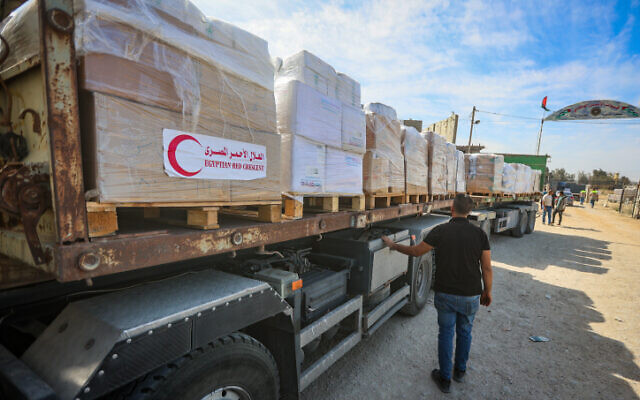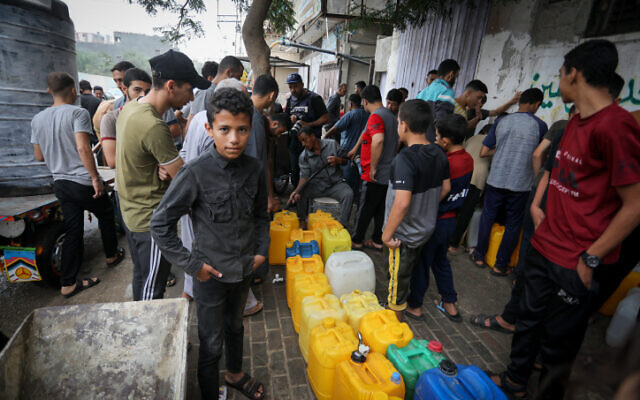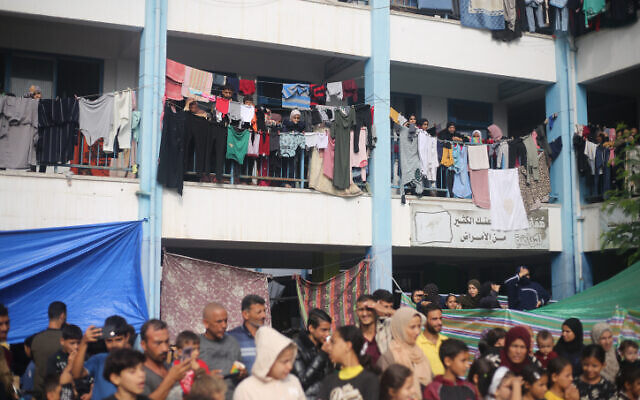The Defense Ministry unit responsible for facilitating the passage of aid into the Gaza Strip said on Tuesday that there is no lack of food, water, or other humanitarian supplies in the territory, and that inventories of critical supplies are being monitored on a daily basis.
In a press briefing to reporters, IDF Col. Elad Goren of the Defense Ministry’s Coordinator of Government Activities in the Territories (COGAT) unit insisted that amid the ongoing war between Israel and Hamas, the levels of humanitarian assistance being supplied to Gaza were well above the minimum levels required by international law, and that the humanitarian situation is being constantly reviewed.
UN agencies such as the Office for the Coordination of Humanitarian Affairs (OCHA) and UNICEF, and other international agencies such as the World Health Organization have deplored the situation in the territory and called for increased supplies to be transferred, but have not stated that there are shortages of critical supplies.
Gaza health authorities, controlled by Hamas, say that more than 10,000 Palestinians have been killed in the fighting, but the figures issued by the terror group cannot be independently verified, and are believed to include its own terrorists and gunmen, as well as Palestinians killed by the hundreds of rockets fired by terror groups that have fallen short inside the Strip.
The IDF’s operation in Gaza was sparked by the October 7 cross-border onslaught perpetrated by Hamas, in which some 1,400 people, mostly civilians, were killed in savage attacks on Israel’s southern communities.
In the COGAT press briefing, Goren, who heads the unit’s civilian department, said the agency is in daily contact with relevant UN and international agencies on the ground and that its own experts were evaluating the humanitarian situation in Gaza ever day.

Trucks with Humanitarian aid arrive at the Palestinian side of the Rafah border crossing with Egypt, in the southern Gaza Strip, on October 21, 2023. (Atia Mohammed/Flash90)
“We check the status of inventories, reported shortages and gaps that arise from this data,” said Goren.
“I can say clearly that we are not remotely close to approaching minimum levels that we are obligated under international law,” he continued, referring to the critical supplies the IDF is committed to providing.
Goren insisted there are enough food supplies in Gaza “for weeks to come,” and said that although water supply in the territory is below normal levels, the current supply “meets humanitarian needs.”
He noted that two of the three water pipelines from Israel to Gaza are operational, and that some of the desalination plants and water treatment facilities that supply the territory with 90 percent of its water during peacetime are operational, particularly in southern Gaza.
Those facilities are running off of fuel supplied by the UN, said Goren, although some of the desalination plants also have solar panels to power their operations.
Israel has barred the entry of fuel into Gaza, arguing that Hamas has stockpiled sufficient fuel reserves for basic humanitarian needs, and that providing more would help the terror group continue to power its vast tunnel network, which it is using in its operations against IDF troops.
OCHA acknowledged in its November 6 update that fuel had been stored in Gaza before the current war, and said it used those reserves to supply 120 municipal water wells across Gaza for pumping operations.

Palestinians fill up water containers in the city of Rafah in the southern Gaza Strip, October 28, 2023. (Abed Rahim Khatib/Flash90)
UNRWA said, however, in its November 6 update that there was “a severe shortage of adequate and sufficient sanitation facilities, including toilets and showers,” leading to waits of one or two hours at their shelters to use such facilities.
Goren also insisted that adequate medical equipment and supplies are available in Gaza, but said it was “managed by Hamas, which choses which medical equipment to keep for themselves and their terrorists, and what to supply to hospitals and when.”
He said that “over 500 trucks” have entered Gaza via the Rafah crossing since the beginning of the war, containing “hundreds of tons of equipment, including water, food, medical equipment, and hygiene supplies.”
Although he insisted that there is no physical shortage of supplies in the entire territory, he acknowledged that access to some vital humanitarian necessities is more difficult in the northern part of the Gaza Strip where the most intense fighting is taking place.
In its Monday update, OCHA reported that a lack of operational bakeries in northern Gaza has meant that people have been making flatbreads with flour and cooking them over fires in their homes.
It said that access to bread in southern Gaza was also challenging since, it said, 11 bakeries have been destroyed in the IDF’s campaign, but that at least nine bakeries were operational in the south and provide bread to UN civilian shelters.
OCHA added that food assistance to internally displaced persons (IDPs) in northern Gaza was “almost completely halted for the past few days” due to the intensification of the IDF’s ground operation.
The organization added that 14 out of 35 hospitals have stopped functioning and 51 of 72 primary care facilities have shut down due to damage or lack of fuel.
OCHA said that about 1.5 million people in Gaza are now IDPs, 717,000 of whom are sheltering in 149 UNRWA facilities; 122,000 in hospitals, churches, and public buildings; 110,000 people in 89 non-UNRWA schools; and the remainder with host families.

Palestinians at an UNRWA facility in Khan Yunis in the southern Gaza Strip, October 23, 2023. (Atia Mohammed/Flash90)
The agency said that overcrowding in the territory is now “a major concern, noting that UN shelters are unable to accommodate new arrivals.
UNRWA, the UN agency that provides welfare and humanitarian services for Palestinian refugees from the 1948 and 1967 wars, said that there were 22,000 IDPs in the Khan Younis Training Centre alone, making it the most overcrowded UNRWA shelter with less than two square meters per person, and at least 600 people are sharing one toilet.
“Conditions in the shelters are inhumane and continue to deteriorate as days go by… The worsening sanitary conditions, along with the lack of privacy and space, pose immense risks to the health and safety of people sheltering,” UNRWA’s November 6 update said.
OCHA said that “the worsening sanitary conditions, along with the lack of privacy and space, generate health and safety hazards,” and that there “thousands of cases of acute respiratory infections, diarrhea and chicken pox” at UNRWA shelters.